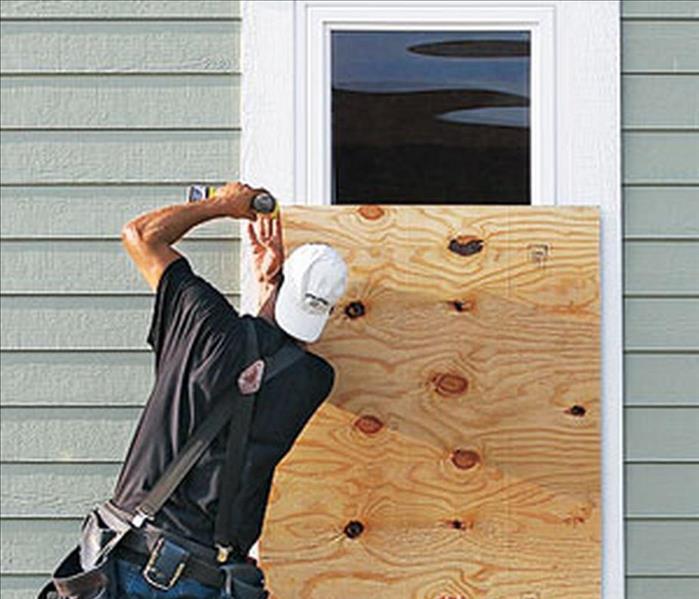Minimizing Damage To Your Home Before A Storm
6/1/2021 (Permalink)
 Hurricane impact windows add protection in the event of a storm. If there is an impending storm you can also board your windows temporarily.
Hurricane impact windows add protection in the event of a storm. If there is an impending storm you can also board your windows temporarily.
Living on a coast with water frontage is a dream of most homeowners. There's nothing like enjoying a cup of coffee or a glass of wine while watching the surf gently caress the shore. The cool breezes blowing off the water give the house an atmosphere lots of homeowners pay a lot of money to have.
The trouble with coastal living is that for a few months out of the year, those breezes turn lethal. The winds surrounding a storm complex throw anything loose against a house, break windows, tear off the roof, and repark your car in strange places.
Storms may be the price we pay for coastal living, but it doesn't have to be too damaging for the checkbook. Securing loose things, trimming back trees, and bringing indoors what could easily become a projectile is a simple and effective way of prepping a house for storms with high-velocity winds. Here's how.
1. Bring In Loose Lawn Furnishings And Toys
Patio furniture, swing sets, climbing toys, grills, trash cans, and planters all become projectiles in hurricane-force winds. Bring them into the basement or garage. Secure your fencing, mailbox, and deck boards as well. The winds can get under things, ripping them out of the ground, and make a mess of them. Hire a professional to help you secure these things well before the storm season.
2. Double-Check Your Trees And Shrubbery
Dead tree branches frequently are ripped from trees and hurled against houses. Have a tree specialist examine your trees and shrubs for dead matter and remove them. If tree limbs are too close to the roof, have them trimmed back. If trees are wrapped around power lines, have them trimmed back. The city or county usually takes care of this, but time is of the essence here. Get it done for the safety of your home.
3. Secure The Roof
The technology built into today's roofing materials takes into account hurricane-force winds. They're usually good for winds up to 140 mph. The best roof materials are metal roofs of tin, zinc, copper, steel, or aluminum. They're a little more expensive, but they last up to 50 or more years. Asphalt shingles only last about ten years before they need replacement. Architectural shingles are made to last 20 to 30 years and to resist winds of up to 130 mph. Before the next storm season, look into replacing the roof.
4. Secure The Windows
Considering the billions of dollars of damages done by recent storms, coastal governments now require homes to have hurricane-impact windows. You might want to upgrade if you live in a home built before this building code was enacted.
Hurricane-impact windows offer heavier, break-resistant frames. They also resist projectiles hurled by 150 mph winds. They protect against water introduction as well as reducing your insurance premiums. You'll want windows with a design pressure rating of 50, which stand up well to hurricane-force winds of 200 mph.
There are different types of shutters that are effective against high-velocity winds. Hurricane shutters are hinged and close on the outside to protect windows. Accordion shutters and Bahama shutters are a little more expensive, but they're all effective protection for your windows.
5. Reinforce Your Doors
Air pressure is the bane of a house. Since your garage door is the largest of your house's doors, it's especially vulnerable to hurricane winds. If it isn't reinforced, it can be snatched off. Air pressure then builds up. It can possibly blow the roof off the house.
To guard against this possibility, install a garage door that's hurricane-resistant. They have reinforcements of steel, springs, and more hardware to strengthen the door. If hurricane garage doors aren't in the budget, you can still prep your garage door using steel panels and storm braces for extra strength.
For the front, back, and basement doors leading outside, fiberglass has been tested for hurricane-force winds. They tend to keep water out very well. They're not cheap, but $150 can get you a basic fiberglass door resistant to wind and rain.
Tip: Did you know that closing all the doors in the house including the garage door reduces air pressure by 30 percent? This gives the roof a better chance of sticking around.
6. Secure The HVAC Unit
One thing you don't want crashing into your house is your HVAC unit. Prep it before a storm by strapping it down. Use a cage or trap around the unit to prevent blowing debris from damaging it. Clear foliage around the unit to prevent clogging the fins. Hire an HVAC professional to service the unit before the storm. Buy a backup generator in case of a power outage.
During the storm, turn off the circuit breaker to the unit to prevent damage. Following the storm, have an HVAC professional check the unit over to make sure it's safe to use. Do not, repeat, do not turn on the unit if there's standing water around it.
7. Important Things To Heed
Make sure your gutters are cleaned before storm season rolls around. Ensure the downspouts are clear and pointed away from the foundation.
Make an inventory of your home's belongings, both inside and outside. Take pictures of the property before the storm season arrives. This will make any insurance claims a little easier on everyone.
If you can fit them in, put your cars in the garage to protect them from damage.
Build a survival kit of medical supplies, a hand-crank radio and flashlight for remaining informed, and enough food and water per person for at least five days.





 24/7 Emergency Service
24/7 Emergency Service